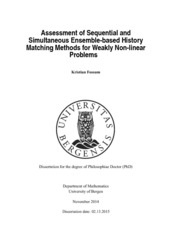Assessment of Sequential and Simultaneous Ensemble-based History Matching Methods for Weakly Non-linear Problems
Doctoral thesis
Permanent lenke
https://hdl.handle.net/1956/9398Utgivelsesdato
2015-02-13Metadata
Vis full innførselSamlinger
Sammendrag
The ensemble Kalman filter (EnKF) has, since its introduction in 1994, gained much attention as a tool for sequential data assimilation in many scientific areas. In recent years, the EnKF has been utilized for estimating the poorly known petrophysical parameters in petroleum reservoir models. The ensemble based methodology has inspired several related methods, utilized both in data assimilation and for parameter estimation. All these methods, including the EnKF, can be shown to converge to the correct solution in the case of a Gaussian prior model, Gaussian data error, and linear model dynamics. However, for many problems, where the methods are applied, this is not satisfied. Moreover, several numerical studies have shown that, for such cases, the different methods have different approximation error. Considering parameter estimation for problems where the model depends on the parameters in a non-linear fashion, this thesis explore the similarities and differences between the EnKF and the alternative methods. Several characteristics are established, and it is shown that each method represents a specific combination of these characteristics. By numerical comparison, it is further shown that a variation of the characteristics produce a variation of the approximation error. A special emphasis is put on the effect of one characteristic, whether data are assimilated sequentially or simultaneously. Typically, several data types are utilized in the parameter estimation problem. In this thesis, we assume that each data depends on the parameters in a specific non-linear fashion. Considering the assimilation of two weakly non-linear data with different degree of non-linearity, we show, through analytical studies, that the difference between sequential and simultaneous assimilation depends on the combination of data. Via numerical modelling, we investigate the difference between sequential and simultaneous assimilation on toy models and simplified reservoir problems. Utilizing realistic reservoir data, we show that the assumption of difference in non-linearity for different data holds. Moreover, we demonstrate that, for favourable degree of nonlinearity, it is beneficial to assimilate the data ordered after ascending degree of nonlinearity.
Består av
Paper I: K. Fossum, T. Mannseth, D. S. Oliver, and H. J. Skaug, Numerical Comparison of Ensemble Kalman Filter and Randomized Maximum Likelihood, in Proceedings of the 13th European Conference on the Mathematics of Oil Recovery (ECMOR XIII), Biarritz, France, 10-13 September 2012. Full text not available in BORA due to publisher restrictions. The article is available at: http://dx.doi.org/10.3997/2214-4609.20143174 .Paper II: K. Fossum, and T. Mannseth, Parameter sampling capabilities of sequential and simultaneous data assimilation. Part I: analytical comparison, Inverse Problems 30, 114002, 2014. Full text not available in BORA due to publisher restrictions. The article is available at: http://dx.doi.org/10.1088/0266-5611/30/11/114002.
Paper III: K. Fossum, and T. Mannseth, Parameter sampling capabilities of sequential and simultaneous data assimilation. Part II: statistical analysis of numerical results Inverse Problems 30, 114003, 2014. Full text not available in BORA due to publisher restrictions. The article is available at: http://dx.doi.org/10.1088/0266-5611/30/11/114003.
Paper IV: K. Fossum, and T. Mannseth, Evaluation of ordered sequential assimilation for improved EnKF sampling, in Proceedings of the 14th European Conference on the Mathematics of Oil Recovery (ECMOR XIV), Catania, Sicily, Italy, 8-11 September 2014. Full text not available in BORA due to publisher restrictions. The article is available at: http://dx.doi.org/10.3997/2214-4609.20141790.
Paper V: K. Fossum, and T. Mannseth, Assessment of ordered sequential data assimilation. Full text not available in BORA.
